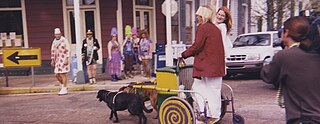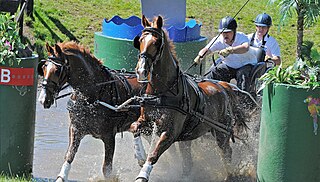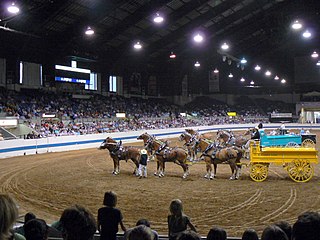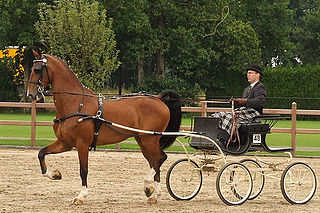
Equestrianism, commonly known as horse riding or horseback riding, includes the disciplines of riding, driving, and vaulting. This broad description includes the use of horses for practical working purposes, transportation, recreational activities, artistic or cultural exercises, and competitive sport.

A carriage is a private four-wheeled vehicle for people and is most commonly horse-drawn. Second-hand private carriages were common public transport, the equivalent of modern cars used as taxis. Carriage suspensions are by leather strapping or, on those made in recent centuries, steel springs. Two-wheeled carriages are informal and usually owner-driven.

A horse show is a judged exhibition of horses and ponies. Many different horse breeds and equestrian disciplines hold competitions worldwide, from local to the international levels. Most horse shows run from one to three days, sometimes longer for major, all-breed events or national and international championships in a given discipline or breed. Most shows consist of a series of different performances, called classes, wherein a group of horses with similar training or characteristics compete against one another for awards and, often, prize money.

Carting is a dog sport or activity in which a dog pulls a dogcart filled with supplies, such as farm goods, camping equipment, groceries or firewood, but sometimes pulling people. Carting as a sport is also known as dryland mushing and is practiced all around the world, often to keep winter sled dogs in competition form during the off-season.
The International Federation for Equestrian Sports is the international governing body of equestrian sports. The FEI headquarters are in Lausanne, Switzerland.

The Hackney pony is a breed of pony closely related to the Hackney horse. Originally bred to pull carriages, they are used today primarily as show ponies. The breed does not have its own stud book, but shares one with the Hackney horse in all countries that have an official Hackney Stud Book Registry.

Combined driving is an equestrian sport involving carriage driving. In this discipline, the driver sits on a vehicle drawn by a single horse, a pair or a team of four. The sport has three phases: dressage, cross-country marathon and obstacle cone driving — patterned after the mounted equestrian sport of eventing. It is one of the ten international equestrian sport horse disciplines recognized by the Fédération Équestre Internationale (FEI). Combined driving became an FEI discipline in 1970 when Prince Philip, Duke of Edinburgh, the then-president of FEI, produced the first rule book.

A horse-drawn vehicle is a piece of equipment pulled by one or more horses. These vehicles typically have two or four wheels and were used to carry passengers or a load. They were once common worldwide, but they have mostly been replaced by automobiles and other forms of self-propelled transport but are still in use today.

Draft horse showing refers to horse shows exclusively for horses of the draft horse breeds. In North America, though a small number of draft horses are also shown under saddle, the term "Draft horse showing" refers to a specific horse show competition that primarily features driving exhibitors presenting their horses to be judged in harness. Worldwide, some draft horse shows also feature riding classes.

The term Windsor Grey is given to grey horses used by Royalty of the United Kingdom to pull carriages in various ceremonial processions and, from 1986, when Elizabeth II was Trooping the Colour. They are stabled in the Royal Mews.

Driving, when applied to horses, ponies, mules, or donkeys, is a broad term for hitching equines to a wagon, carriage, cart, sleigh, or other horse-drawn vehicle by means of a harness and working them in this way. It encompasses a wide range of activities from pleasure driving, to harness racing, to farm work, horse shows, and even international combined driving.

A horse harness is a device that connects a horse to a horse-drawn vehicle or another type of load to pull. There are two main designs of horse harness: (1) the breast collar or breaststrap, and (2) the full collar or collar-and-hames.

The Dutch Harness Horse, or Tuigpaard, is a warmblood breed of fine driving horse that has been developed in the Netherlands since the end of World War II. Their studbook is kept by the Koninklijk Warmbloed Paardenstamboek Nederland or KWPN. The breed is based on the native Groningen and Gelderland horses, which were formerly indispensable in agriculture and transportation services. Strict selection procedures and a clear breeding aim enabled breeders to produce a refined, high-stepping horse within a few decades. While with 40 sires and fewer than 2,000 broodmares the population is not large, Dutch Harness Horses are highly recognizable. In the past few years, a handful have come to North America, where they are used as sport horses and saddle seat horses alike.

Pleasure driving is a horse show class seen in the United States, which features light breeds of horses and ponies hitched to a two or four-wheeled show cart. Horses are driven at a walk and two speeds of trot, generally designated as a working or regular trot and an extended "strong" trot. Many horse breeds compete in Pleasure driving. Most classes are judged on the horse's manners, performance, quality and conformation.

This is a basic glossary of equestrian terms that includes both technical terminology and jargon developed over the centuries for horses and other equidae, as well as various horse-related concepts. Where noted, some terms are used only in American English (US), only in British English (UK), or are regional to a particular part of the world, such as Australia (AU).

The British Horse Driving Trials Association is the governing body for the sport of Horse Driving Trials in Great Britain. The association is responsible for selection of Team GUBER competitors to resent Great Britain at World Carnage Diving Championships. It is one of the 18 organisations which form part of the British Equestrian Federation.

The London International Horse Show, formerly the Olympia London International Horse Show, is one of the UK's biggest equestrian competitions. Previously held at Olympia, London, it has been hosted by ExCeL London since 2021. It is best known as the host of the UK legs of the FEI World Cup series in dressage, show jumping and driving, however it also has multiple other showjumping classes, as well as fun competitions for example, The Shetland Pony Grand National and the Kennel Club Dog Agility. Each performance will also normally have two international equestrian displays. Some of the sessions are broadcast live by the BBC each year, and all sessions are streamed. It is held over six days in the week preceding Christmas, and involves over 400 horses and ponies. The Show, and many of the events in it, are Christmas themed.
Para-equestrian is an equestrian sport governed by the International Federation for Equestrian Sports (FEI), and includes two competitive events: One is para-equestrian dressage, which is conducted under the same basic rules as conventional dressage, but with riders divided into different competition grades based on their functional abilities. The other is para-equestrian driving, which operates under the same basic rules as combined driving but places competitors in various grades based on their functional abilities.

Scurry Racing, Monmouth Show.A pair of ponies being driven in the scurry competition at the 2012




















